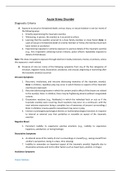Acute Stress Disorder
Diagnostic Criteria
A. Exposure to actual or threatened death, serious injury, or sexual violation in one (or more) of
the following ways:
1. Directly experiencing the traumatic event(s).
2. Witnessing, in person, the event(s) as it occurred to others.
3. Learning that the event(s) occurred to a close family member or close friend. Note: In
cases of actual or threatened death of a family member or friend, the event(s) must have
been violent or accidental.
4. Experiencing repeated or extreme exposure to aversive details of the traumatic event(s)
(e.g., first responders collecting human remains, police officers repeatedly exposed to
details of child abuse).
Note: This does not apply to exposure through electronic media, television, movies, or pictures, unless
this exposure is work related.
B. Presence of nine (or more) of the following symptoms from any of the five categories of
intrusion, negative mood, dissociation, avoidance, and arousal, beginning or worsening after
the traumatic event(s) occurred:
Intrusion Symptoms
1. Recurrent, involuntary, and intrusive distressing memories of the traumatic event(s).
Note: In children, repetitive play may occur in which themes or aspects of the traumatic
event(s) are expressed.
2. Recurrent distressing dreams in which the content and/or affect of the dream are related
to the event(s). Note: In children, there may be frightening dreams without recognizable
content.
3. Dissociative reactions (e.g., flashbacks) in which the individual feels or acts as if the
traumatic event(s) were recurring. (Such reactions may occur on a continuum, with the
most extreme expression being a complete loss of awareness of present surroundings.)
Note: In children, trauma-specific reenactment may occur in play.
4. Intense or prolonged psychological distress or marked physiological reactions in response
to internal or external cues that symbolize or resemble an aspect of the traumatic
event(s).
Negative Mood
5. Persistent inability to experience positive emotions (e.g., inability to experience
happiness, satisfaction, or loving feelings).
Dissociative Symptoms
6. An altered sense of the reality of one’s surroundings or oneself (e.g., seeing oneself from
another’s perspective, being in a daze, time slowing).
7. Inability to remember an important aspect of the traumatic event(s) (typically due to
dissociative amnesia and not to other factors such as head injury, alcohol, or drugs).
Avoidance Symptoms
Palane Mohlala





